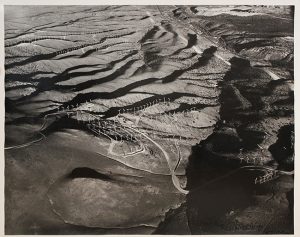
![]() Aerial photographer Marilyn Bridges is well known for her photographs of ancient sacred landscapes around the world, with bird’s-eye images that range from the temples of ancient Greece to serpent mounds in Ohio. Nevertheless, she sees all landscapes as historical documents that have been shaped by natural and human forces. As Bridges has written, “I wish to show the subtle symbols that man creates unintentionally in the environment. Through the markings and objects he leaves on the landscape, he reveals his relationship with the earth.”[footnote]Marilyn Bridges, The Sacred and Secular: A Decade of Aerial Photography (New York: International Center of Photography, 1990), p. 60.[/footnote]
Aerial photographer Marilyn Bridges is well known for her photographs of ancient sacred landscapes around the world, with bird’s-eye images that range from the temples of ancient Greece to serpent mounds in Ohio. Nevertheless, she sees all landscapes as historical documents that have been shaped by natural and human forces. As Bridges has written, “I wish to show the subtle symbols that man creates unintentionally in the environment. Through the markings and objects he leaves on the landscape, he reveals his relationship with the earth.”[footnote]Marilyn Bridges, The Sacred and Secular: A Decade of Aerial Photography (New York: International Center of Photography, 1990), p. 60.[/footnote]
Among the objects on the landscape that drew Bridges’ eye in the mid-1980s were windmill farms and natural gas tanks, which she saw as post-1970s oil crisis signs of important alternate energy sources. In particular, she photographed newly-constructed windmills at the Tehachapi Pass Wind Farm, located in California between the San Joaquin Valley and the Mojave Desert, where windmill construction began in the early 1980s. While early windmill technology used single blade turbines, as seen in Bridge’s photograph, the construction of double and then three-blade blade turbines have made the Tehachapi Pass wind farm one of the largest wind generating regions in the world.
Generating power with windmills in Vermont has faced intense local opposition, with the importance of tapping sources of renewal energy to combat climate change opposed by the need to preserve Vermont’s scenic landscape.